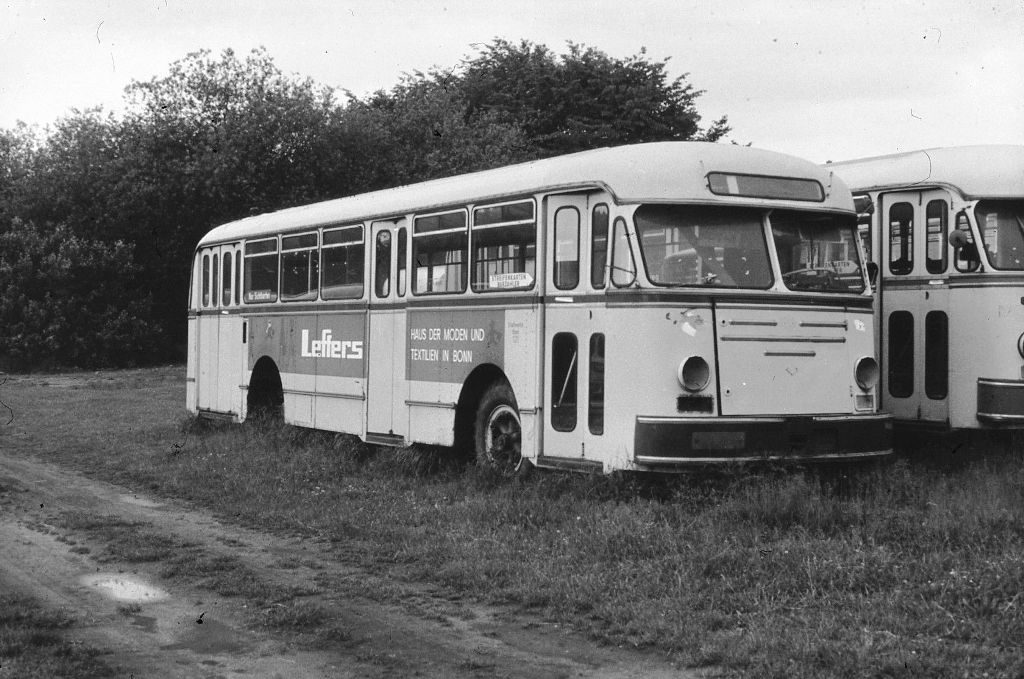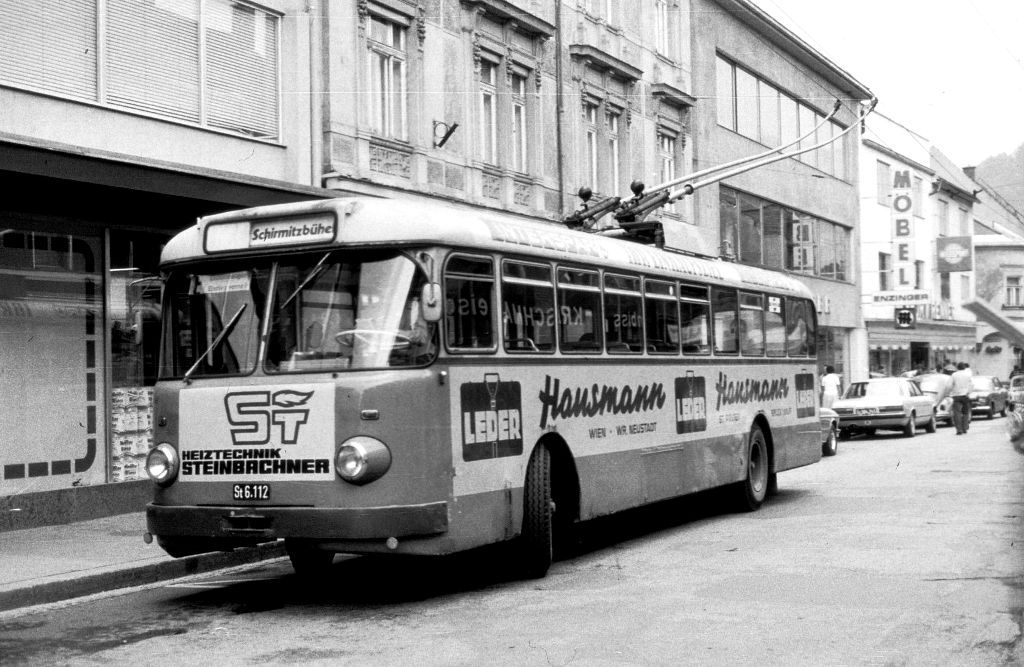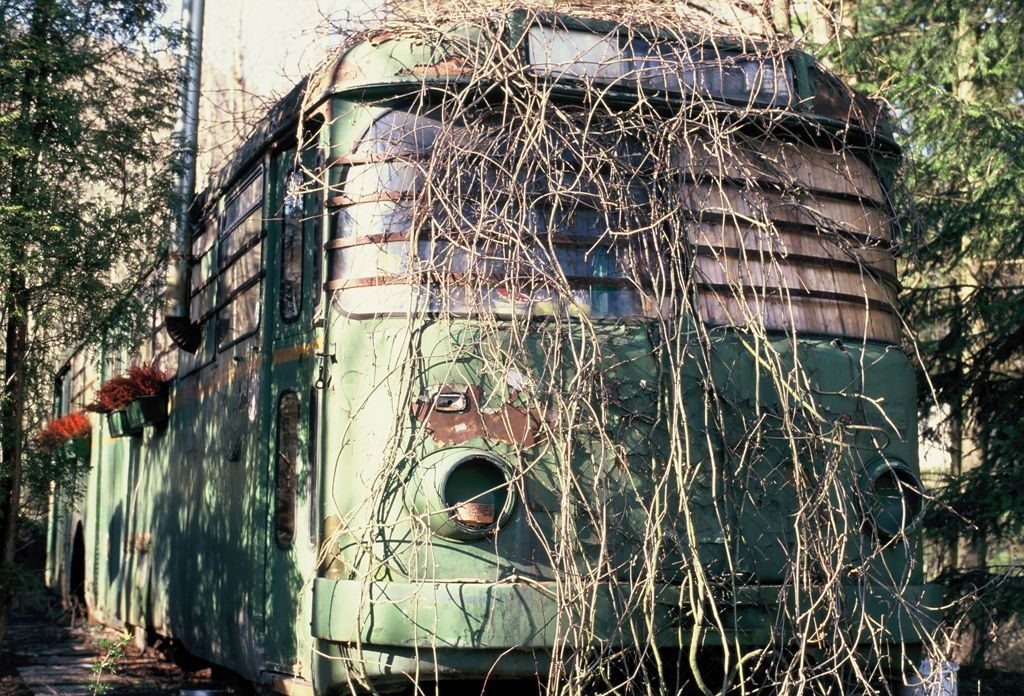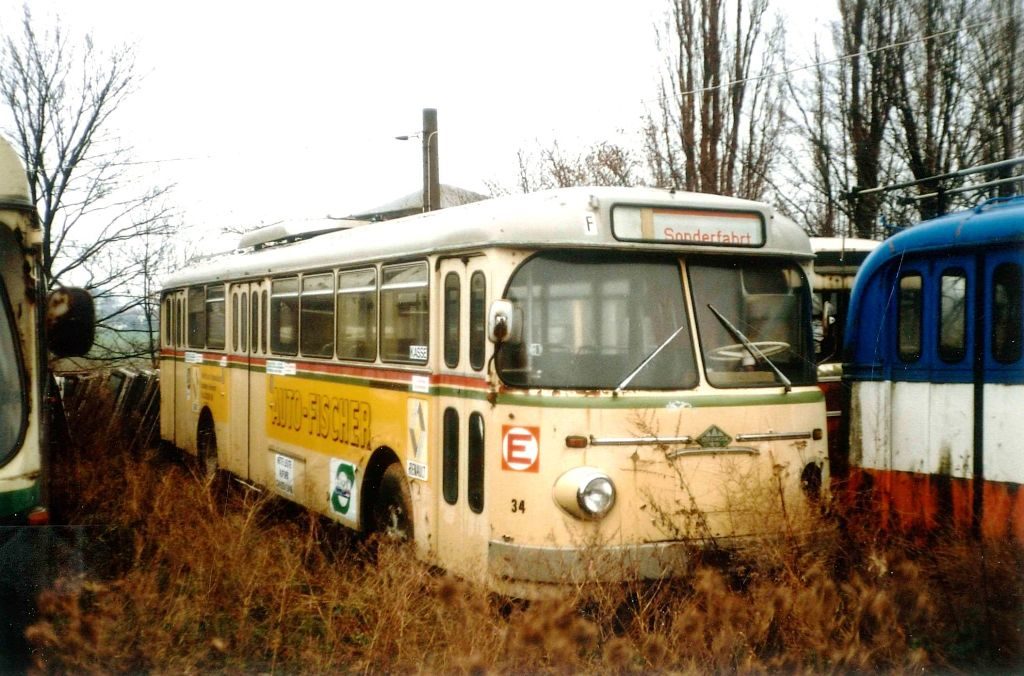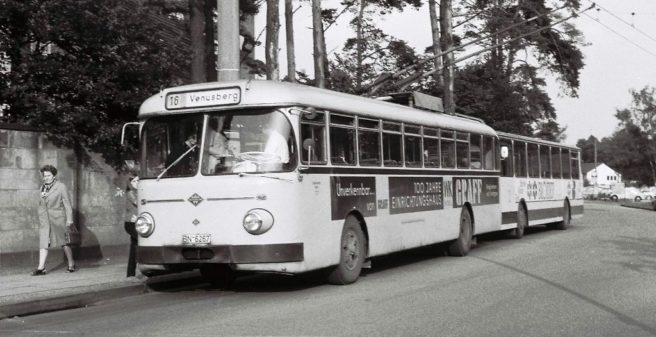
On 17 February 1951, a new mode of transport was launched in Bonn, back then the capital of the Federal Republic of Germany for almost a year and a half. Bonn’s first trolleybus line no. 15 was inaugurated on the following route: Mozartstraße – Hauptbahnhof – Markt – Koblenzer Straße (today Adenauerallee) – Siebengebirgsstraße (today Heussallee) – Bundeshaus – Drachenfelsstraße (today Kurt-Schumacher-Straße) – Gronau. At the main station was reached by a large loop: Nordunterführung – Herwarthstraße – Endenicher Straße – Mozartstraße (here the actual terminus) – Bachstraße – Nordunterführung.
Between the main station and Gronau, the new trolleybus line 15 replaced tram line 4, which had previously offered this connection with a slightly different route in the inner city.
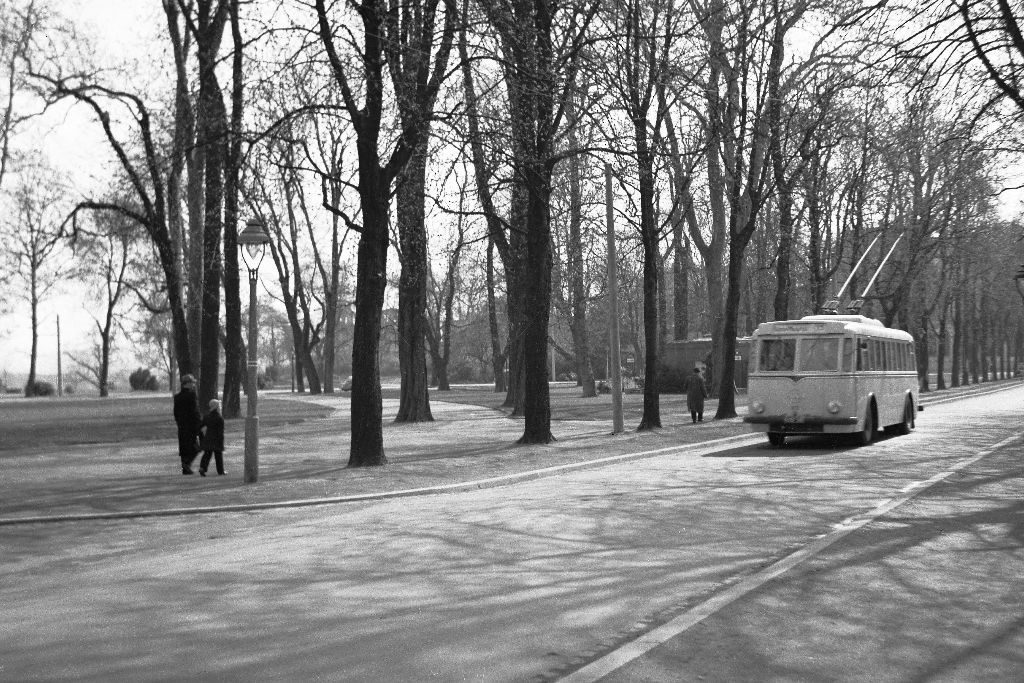
Bonn’s first trolleybuses
As early as in autumn 1950, the first four MAN MKE trolleybuses (201 – 204) were delivered, followed by the identical car 205 just in time for the opening of operations.
These buses were contracted by MAN, but the body work had been subcontracted to Kässbohrer in Ulm, as the former MAN bus factory plant in Nuremberg had been completely destroyed during the war and had not yet been rebuilt.
Two urban transport companies in Bonn
Since August 1925, Bonn’s local public transport system had consisted of two separate legal entities:
- Bahnen der Stadt Bonn (tramway operation)
- Bonner Verkehrs Gesellschaft (BVG) (bus operation)
There were historical reasons for this. BVG was founded in 1925 by ten shareholders, of which the city of Bonn was only one, albeit the largest. Originally, the BVG was supposed to take care of interurban bus routes only. The BVG was founded in order to prevent too much influence of the “Reichspost” bus routes in the Bonn region.
.
In 1932, the BVG became a wholly-owned subsidiary of the city of Bonn, which did not lead to an adjustment of the legal construction of the Bonn public transport system with two companies. (Source for the BVG: Stadtarchiv Bonn). Note: it was not until 01.01.1982 that the SWB handed over their interurban lines, some of which in operation since 1925, to the RVK.
The new trolleybus operation was not assigned to the bus operation, but to the tram operation “Bahnen der Stadt Bonn”. Initially, the trolleybuses were allocated at the Friesdorf depot of the “Strassenbahn Bonn – Bad Godesberg – Mehlem” (and thus to the former municipal borders outside Bonn in the still independent Godesberg). Given the problem that there was no overhead for the trolleybuses between this depot and the the line, the trollybuses had to be towed by a tractor back and forth from the Gronau terminus.
Expanding the network
The first expansion of the Bonn trolleybus operation occured on 22 March 1952. The line was extended from Mozartstraße via Endenicher Straße – the city center of Endenich – Euskirchener Straße – the city center of Duisdorf and the federal ministries in Lengsdorf.
The entire line Gronau – Lengsdorf used the number plate 35 for a short period of time, which was supplemented by the existing line 15 between the main station (Mozartstraße) and Gronau. There was another turning facility from Markt (at Bischofsplatz) via Rathausgasse, Belderberg, Franziskanerstraße and Stockenstraße back to Bischofsplatz, to allow short working to and from Lengsdorf.
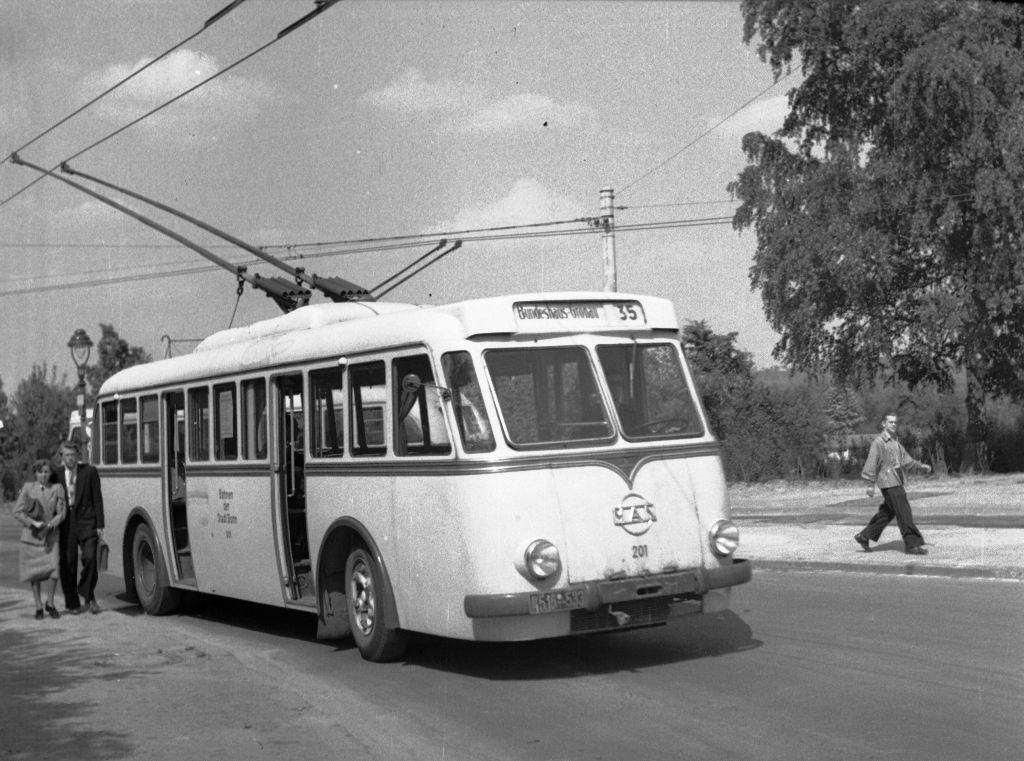
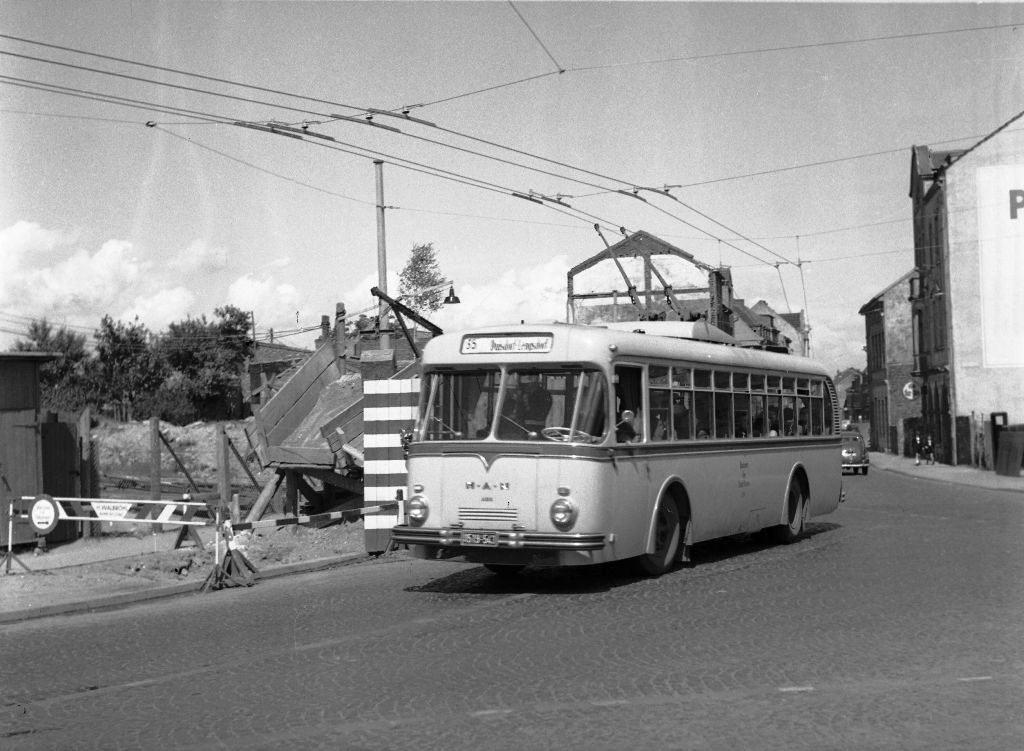
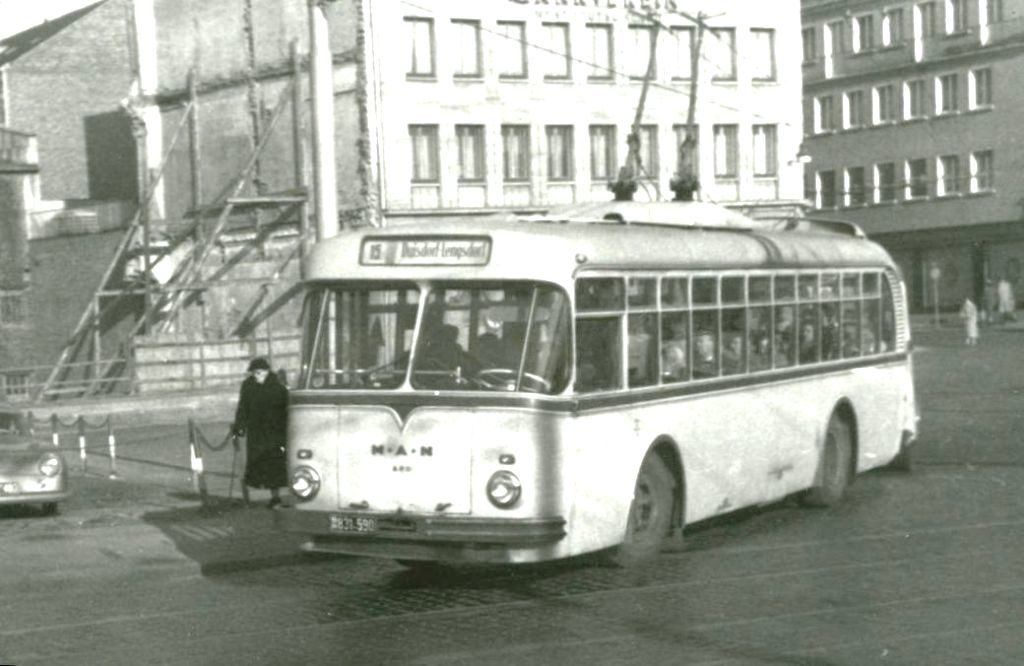
There was another turning facility from Markt (at Bischofsplatz) via Rathausgasse, Belderberg, Franziskanerstraße and Stockenstraße back to Bischofsplatz, to allow short working to and from Lengsdorf.
On 14 November 1953, the next extension of the Bonn trolleybus network started revenue service. Between the main station and the district of Poppelsdorf, the remaining section of tram line 4 was closed and replaced by the new trolleybus line 16 (Hauptbahnhof – Meckenheimer Allee – Clemens-August-Straße – Clemens-August-Platz – Clemens-August-Platz). The turning loop in Poppelsdorf was on the Clemens-August-Platz – here, as in Lengsdorf, the complete overhead line of the loop was hung on a single lantern. At the main station, a large loop was used: Meckenheimer Allee – Baumschulallee – Bachstraße – Nordunterführung – Hauptbahnhof – SüdUnterder – Quantiusstraße – Meckenheimer Allee.
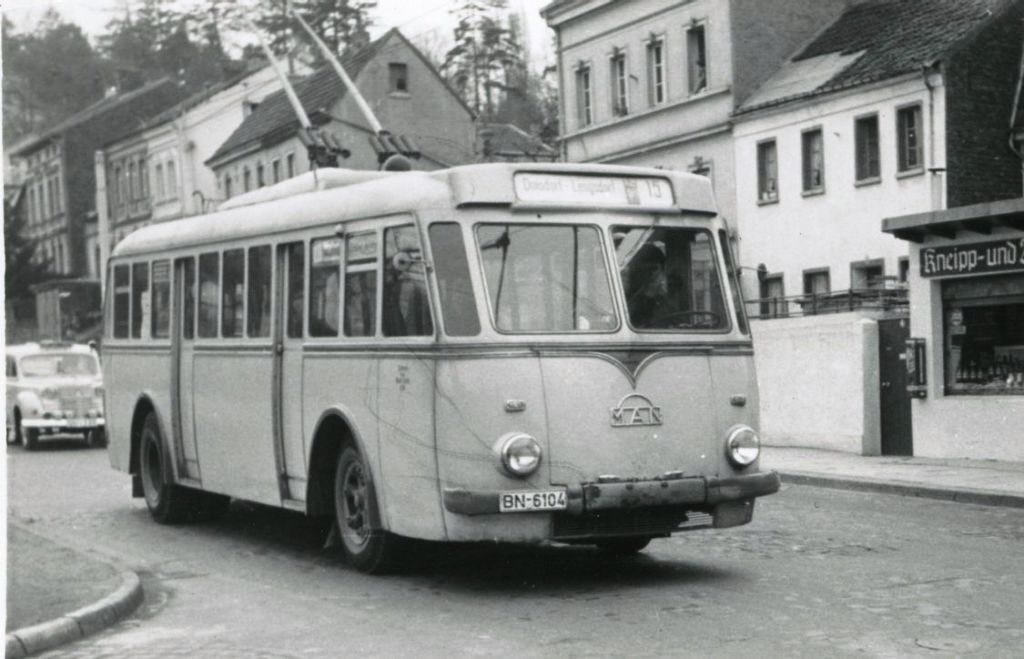
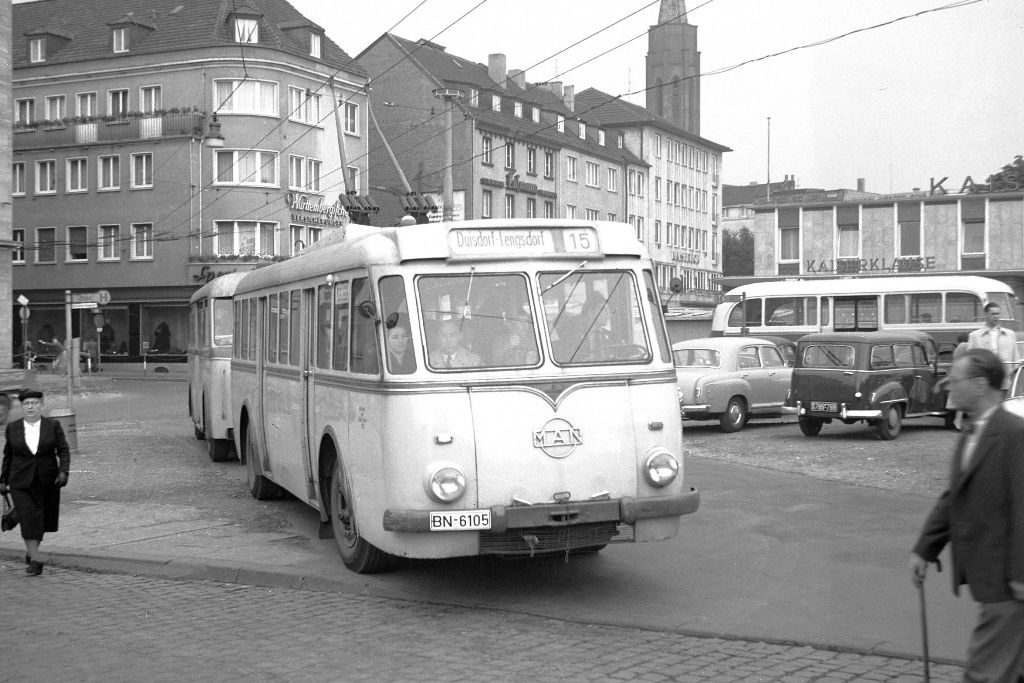
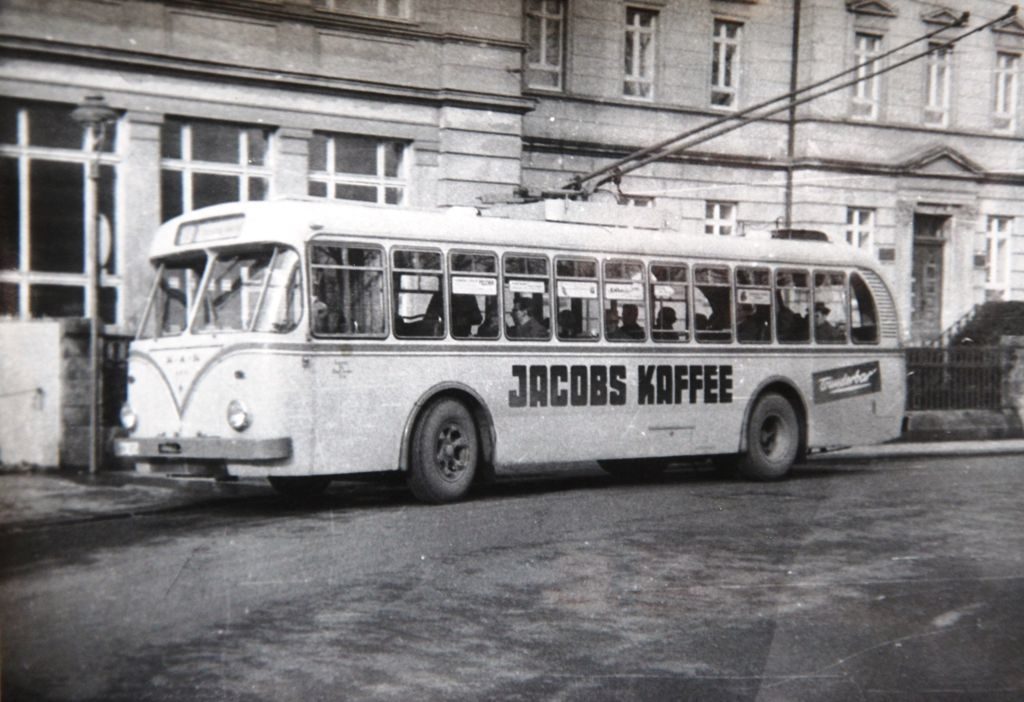
Line 16 was planned to go beyond Poppelsdorf to Venusberg, but in order to achieve this a completely new road had first to be built between Trierer Straße and Zeppelinstraße (today Robert-Koch-Straße). It was named “Im Wingert” and is still an important access road to the Venusberg district today. The author went to the first primary school class (Friedrich-Soennecken-Schule) in the vicinity of the construction site of this street and observed the construction progress of the new street.
On June 27, 1954, line 16 went into operation on its entire length (Hauptbahnhof – Poppelsdorf – Marienhospital – Friedrichsruh – Venusberg). At Venusberg, it did not only serve the university clinics, which had been moved from the city center to a barracks built by the Nazis after the Second World Warbut also numerous public servants, who lived in the large housing complexes, which were built up the hill by the Federal Government.
The terminus on the Venusberg was at the corner of Annaberger Weg (today Sigmund-Freud-Straße) / Kiefernweg. In the middle of the crosspoint was a small lawn, and once again the turning loop was managed by use of one single pole, which was also used as a street light, like in two other final stops as well.
At that time, traffic regulations were much more generous than today. For many years, the trolleybuses spent their break on the Venusberg by parking in the middle of the road, even with their doors open (it was possible to get in and out any time). If a car wanted to pass by, it just drove right past the bus with its open doors … totally unthinkable today. But even then, the waiting position moved after some time to the curb in the Annaberger Weg.
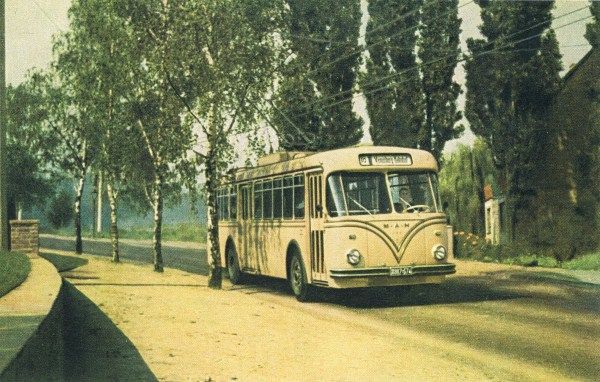
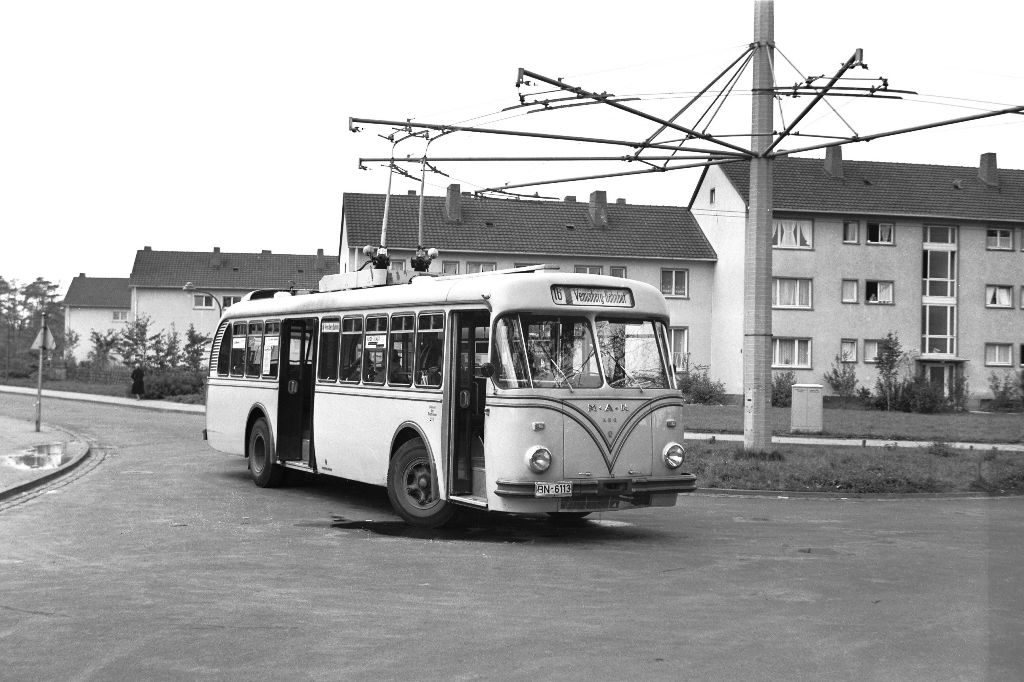
The trailers
Until the ban of bus trailer operations on 1 July 1960, Bonn’s trolleybuses were always operated with trailers. With two exceptions: the trolleybuses 215 and 223. The two municipal transport companies had a total of 30 bus trailers – the BVG the trailers 1 to 20, the “tramways” the trailers 21 to 30. Most of them were built by the Peter Bauer body factory in Cologne-Ehrenfeld (Bauer type OA 5), only two BVG Kässbohrer trailers were bought second-hand from Recklinghausen.
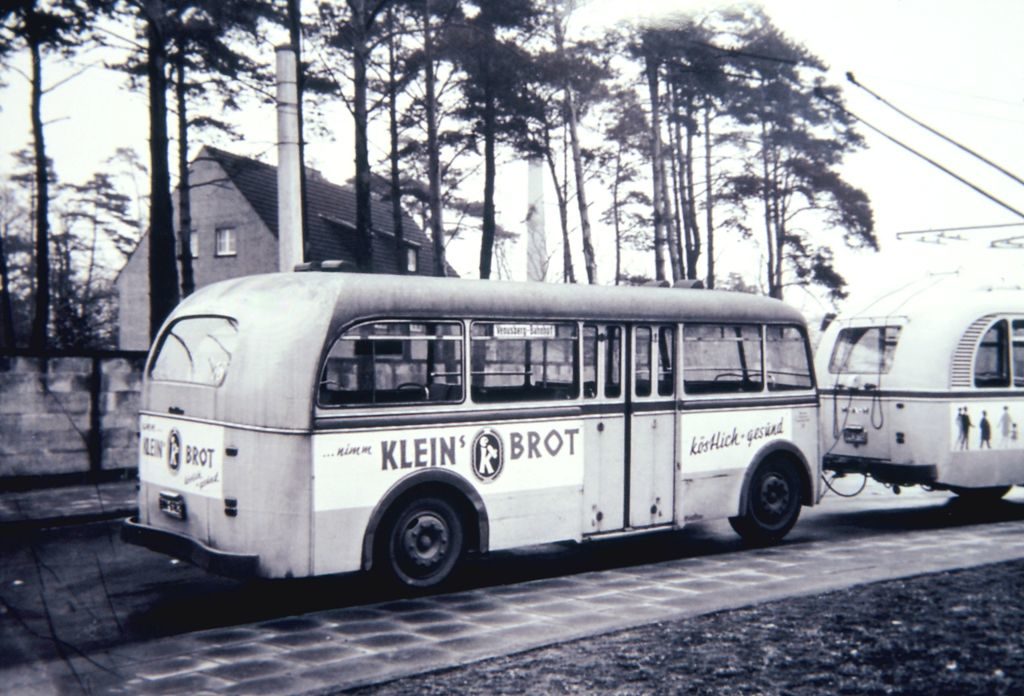
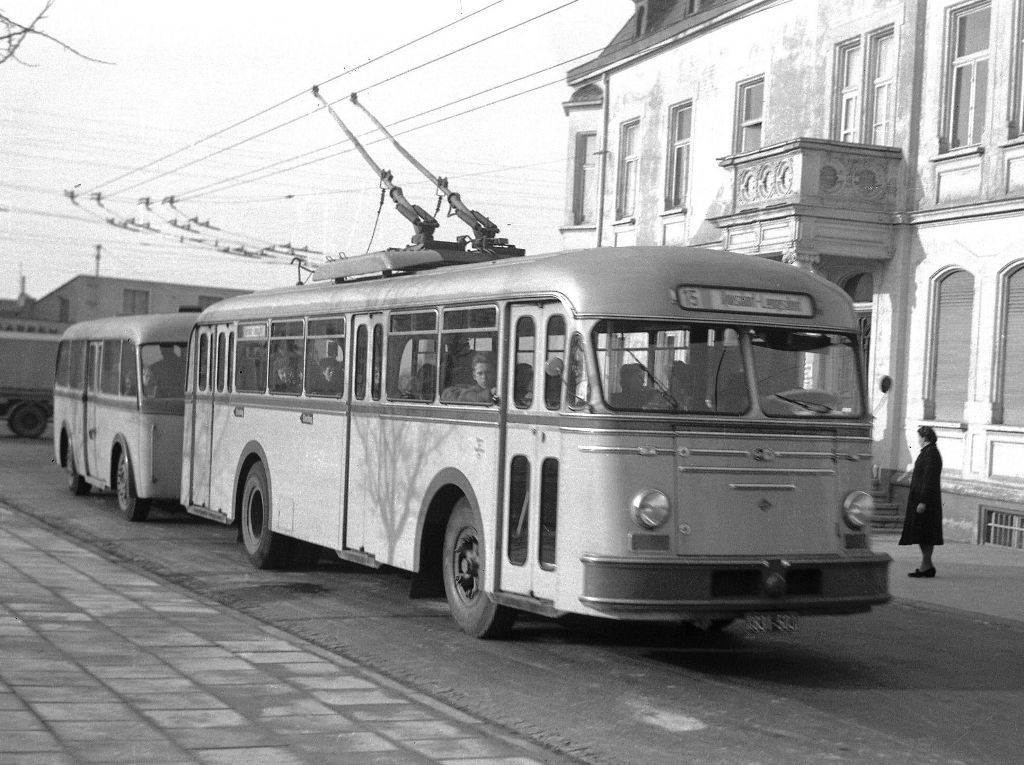
Depot „Obushalle Karlstraße“
The unsatisfactory situation that the trolleybuses had to be towed back and forth between the terminus Gronau and the depot Friesdorf of the “Strassenbahn Bonn – Bad Godesberg – Mehlem” for the service and the suspension of the bus stops did not last long. As late as 1952, a new depot was opened on Karlstraße on the line of line 15 between the main station and the district of Endenich, in which not only the Bonn buses, but also all diesel buses of the BVG now found their home. It was a large concrete-based hall, which could do without pillars inside. And although there were always significantly more diesel and trolleybuses at home, the hall was given the name “Obushalle Karlstraße”. It was demolished around 2000 in order to make place for a shopping center.
„Prototyp“ 215
In 1955, a delegation from the ” Bahnen der Stadt Bonn ” visited an exhibition where MAN showed a trolleybus which was characterized by a number of technical innovations. Finally, the bus was purchased, it joined the fleet as no. 215.
.
1957: the first “Büssing” – in fact an Uerdingen
.
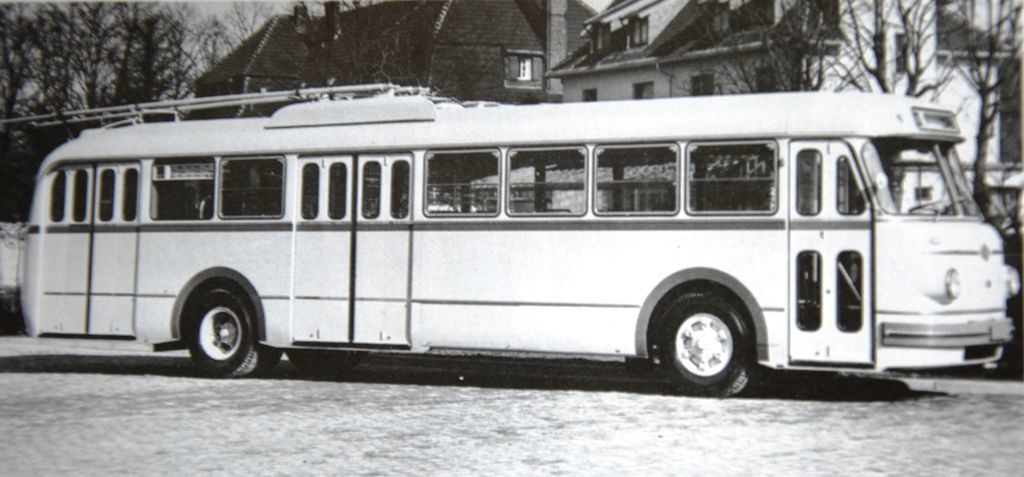
In 1957, another “single piece” joined the fleet: Trolleybus 223, a Uerdingen ÜB IV s, for the first time in Bonn with components from Büssing. The well-known railway factory Uerdingen in Krefeld had designed this type, and the self-supporting integral bus body was offered both as a trolleybus and as a diesel bus. The ones in Bonn were trolleybuses, while in the neighboring city of Cologne they ran in large numbers as diesel, marketed under the model “Büssing/Uerdingen TU 10”, which is incorrect because this type designation would have meant that Uerdingen would have put a body on a chassis from Büssing. Self-supporting integral bus bodies, however, are characterized precisely by the fact that they do not have a conventional chassis, instead, they are formed as one single unit.
No. 223 was not very popular with Bonn’s passengers. The ban on trailers, which came into force on 1 July 1960, was already predictable in 1957, and so the SWB had decided not to equip it with the feature of pulling a trailer. Subsequently, overloading during peak-hours was not uncommon.
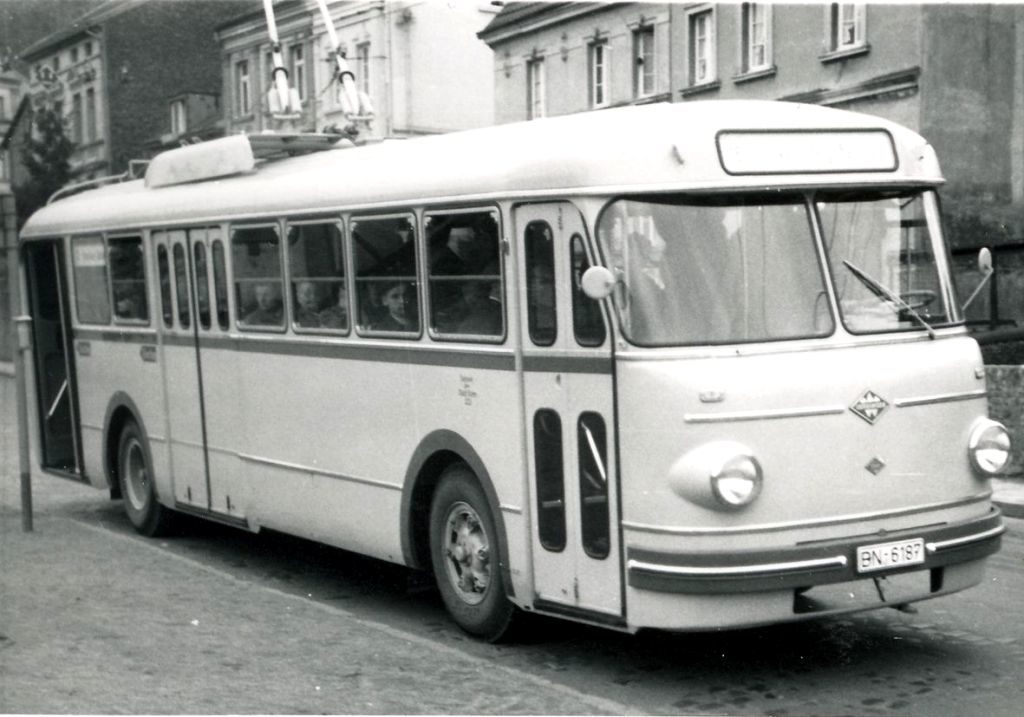
Conversion to one-man operation
Until the mid-sixties, Bonn’s trolleybuses ran with conductors. The MAN with “Pendelschaffner”, who ran back and forth in the car and served the passengers at their place, the three-door Uerdingen (ÜH IIIS and ÜB IV s) had seated conductors at the door in the rear. In the mid-sixties, one-man operation was introduced. Trolleybuses 201 to 207 were scrapped, and only no. 208, the third from the series 206 to 208, was converted with some effort to a one-man operation and renumbered 108. In particular, the separate driver’s door on the left side of the car and the driver’s cab, which these cars had and which of course did not withstand the concept of one-man operation, were removed.
In the case of the Uerdingen, the third door in the rear was converted to passenger self-service – for this, an exemption was required at that time. The passenger opened the door by himself with a button after “clearance” by the driver, and three seconds after no one entered a step plate incorporated in the steps of the door, the door closed automatically.
Merger of BVG and “Bahnen” into SWB
On 1 January 1965, the “Bahnen der Stadt Bonn” and the “Bonner Verkehrs Gesellschaft” were merged into the “Stadtwerke Bonn – Verkehrsbetriebe” (SWB).
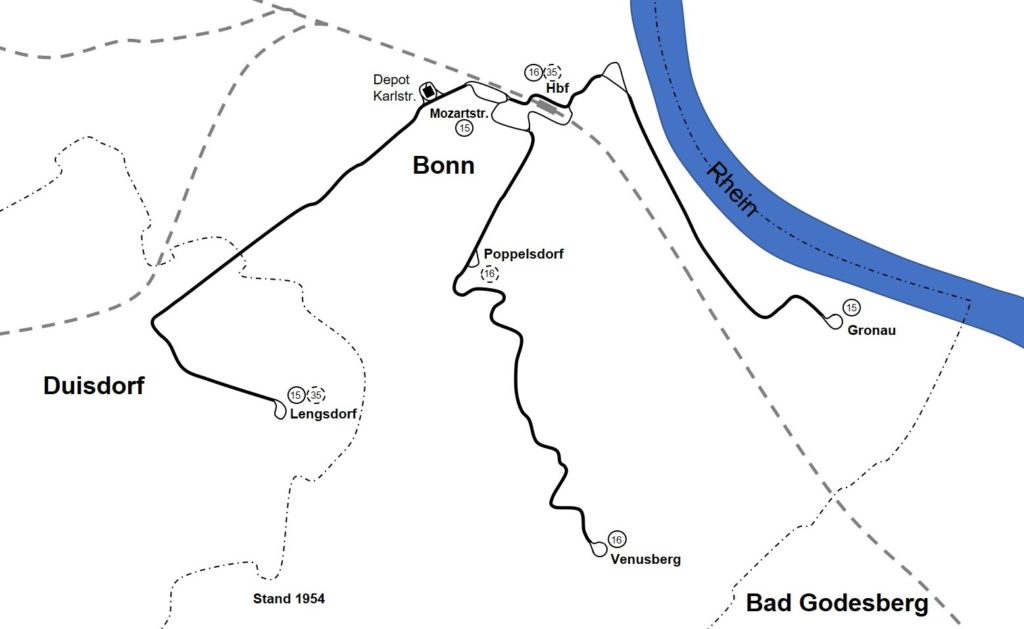
1967: The end of trolleybus line 15
On 1 May 1967, trolleybus line 15 was converted to diesel bus operation. There were two reasons for this: SWB had acquired its first high-capacity one-and-a-half-decker diesel buses from Ludewig in Essen and provided higher passenger capacity, and there were also underground construction works underneath the Adenauerallee (after the death of Konrad Adenauer just renamed “Koblenzer Straße”) pending. The underground construction site repeatedly required temporary traffic rerouting, and no one at the SWB supported investments in new temporary overhead wires for line 15. Simultaneously with the changeover from line 15 to diesel buses, almost all MAN buses went to the scrap, only the two cars 113 and 114 with the Rathgeber bodies remained in place for a short period of time. For good reasons: they were always considered the two best MAN in Bonn.
Line 16: Bonn’s last trolleybus line
Thus Bonn had only one trolleybus line: the 16. For this route five trolleybsues were actually needed, out of a total of eleven vehicles available: the two MAN 113 and 114 as well as the nine Uerdingen. At the end of 1967, the last two MAN also left. The prototype ÜB Ivs no. 123 had a tragic accident in which one person died – its fate was the scrapyard.
The eight Uerdingen 121 – 122 and 124 – 129 were still in use. Nevertheless, during the last years from 1968 to 1971, diesel buses were increasingly in service on line 16. In 1970, the SWB got its first Mercedes-Benz O 305 with automatic transmission numbered 7013.
Photo gallery Bonn – 22 April 1971 – all pictures by: Michael Russell
(Click to open)

126 Meckenheimer Allee / Baumschulallee | @ Michael Russell 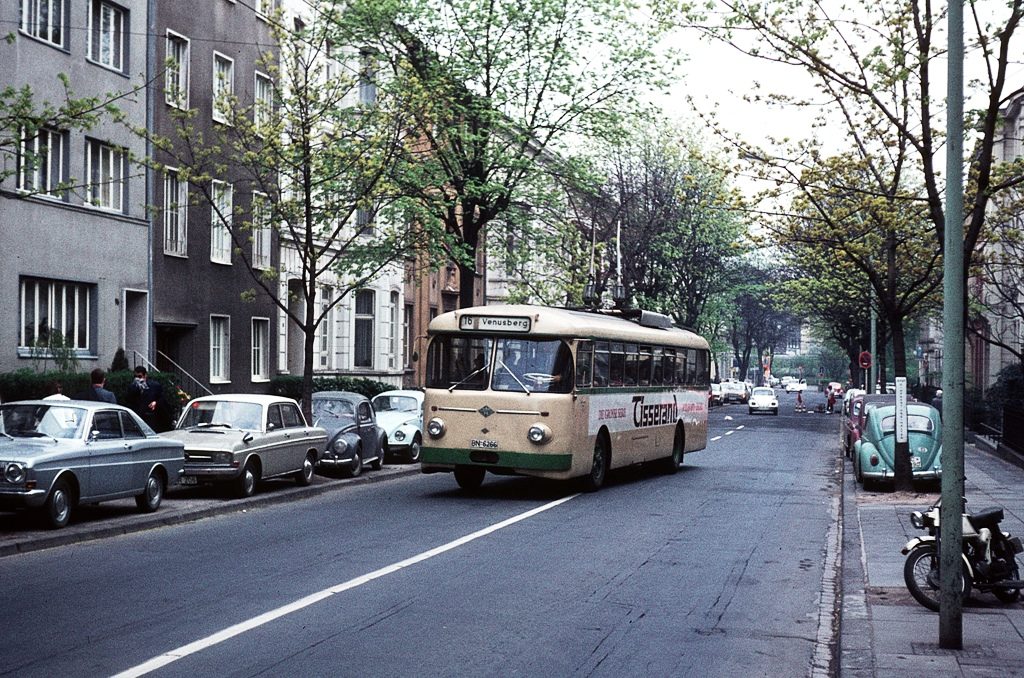
125 Meckenheimer Allee near Baumschulallee | @ Michael Russell 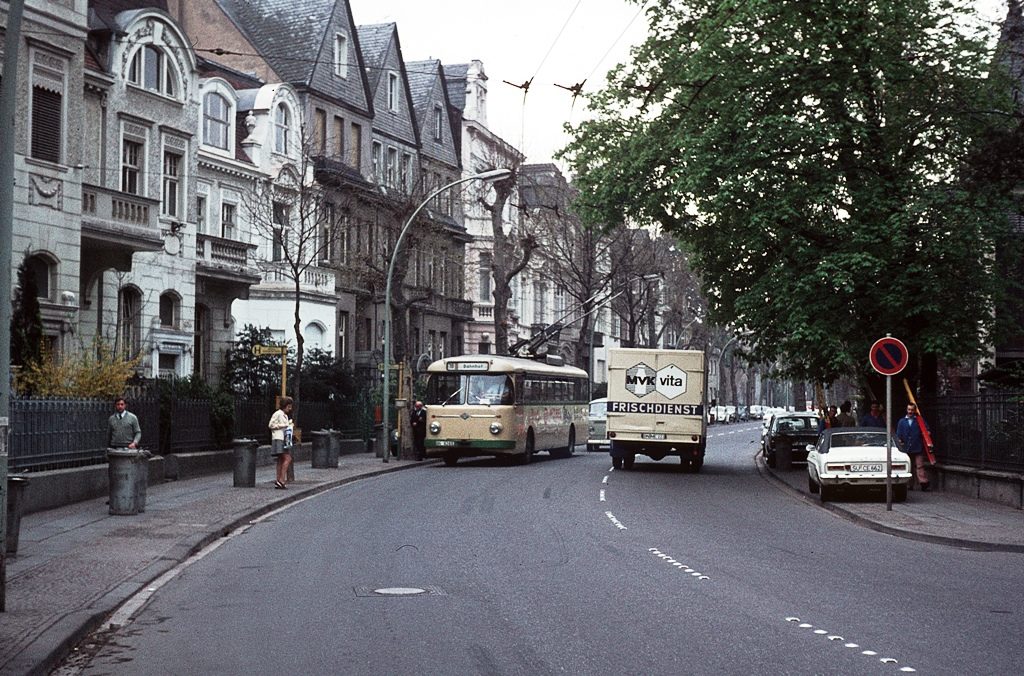
126 Meckenheimer Allee at Beethovenstrasse | @ Michael Russell 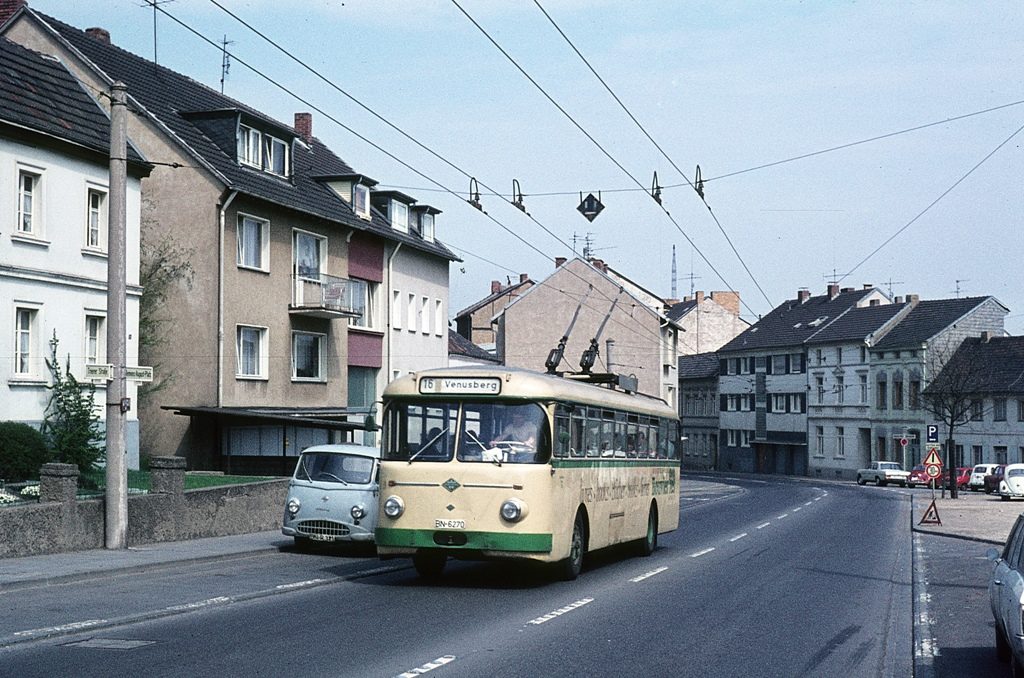
128 Clemens-August-Platz | @ Michael Russell 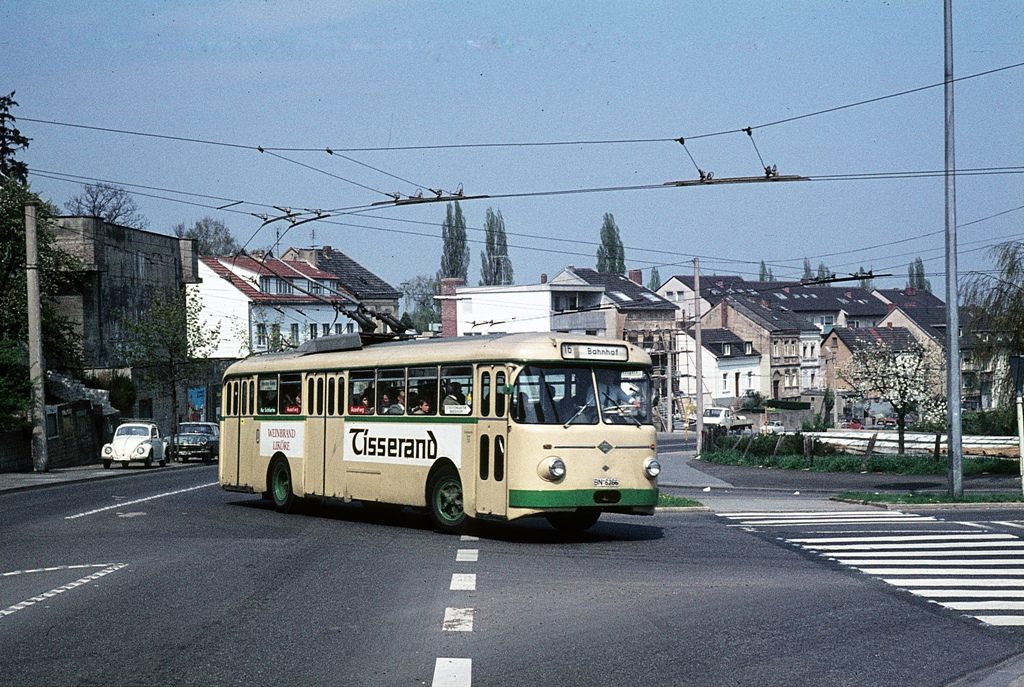
126 Im Wingert / Clemens-August- Platz | @ Michael Russell 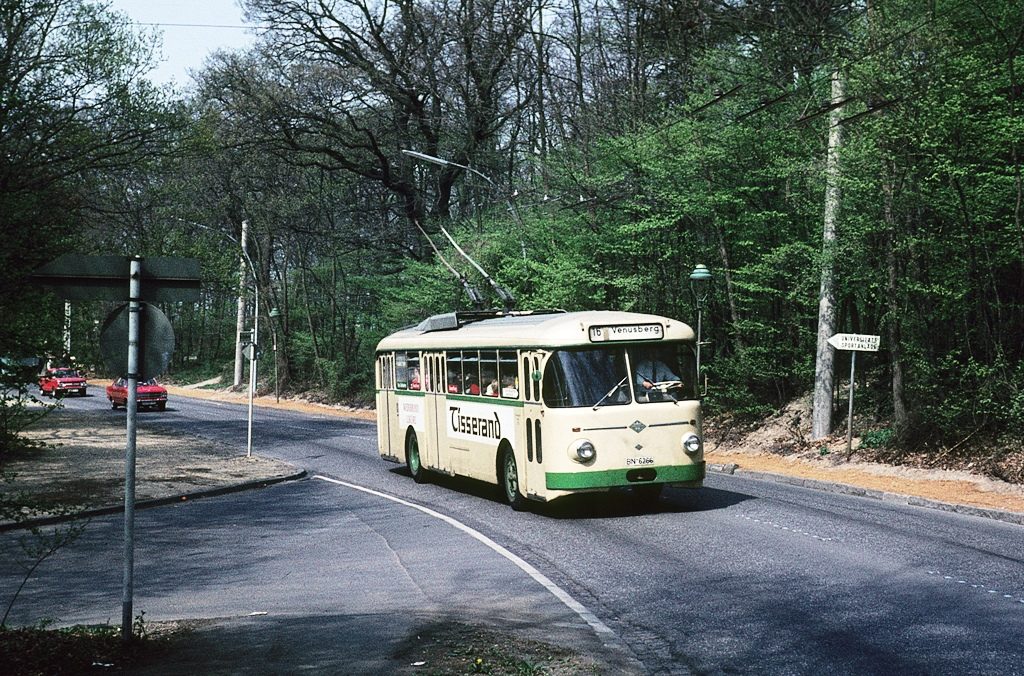
126 Zepppelinstrasse / Nachtigallenweg | @ Michael Russell 
125 Am Paulshof, corner with Haager Weg | @ Michael Russell 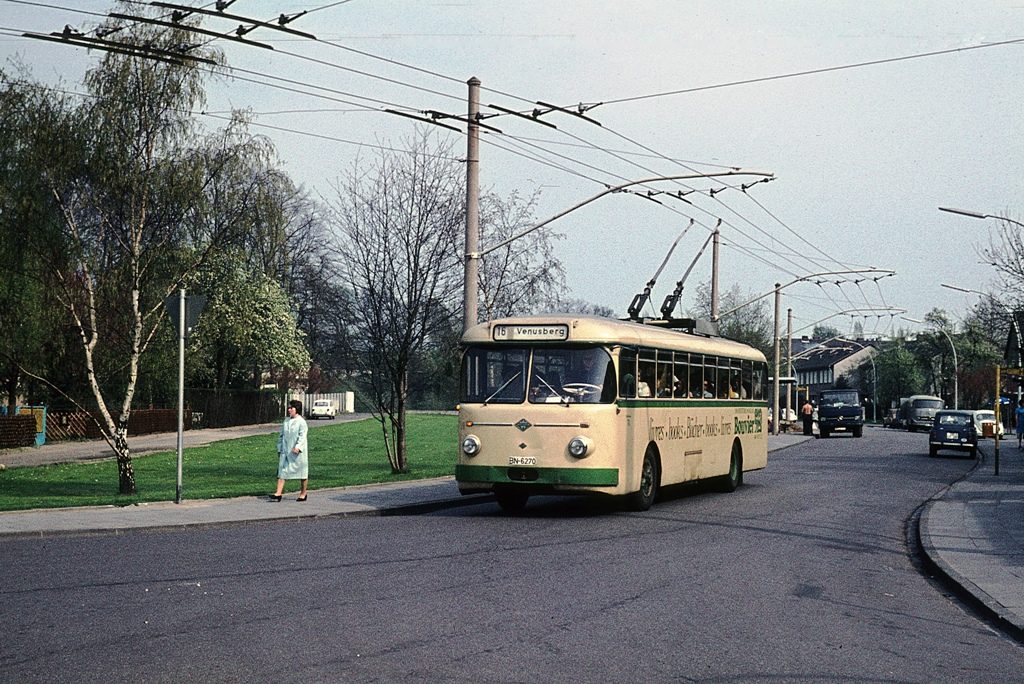
128 Haager Weg / Am Paulshof | @ Michael Russell 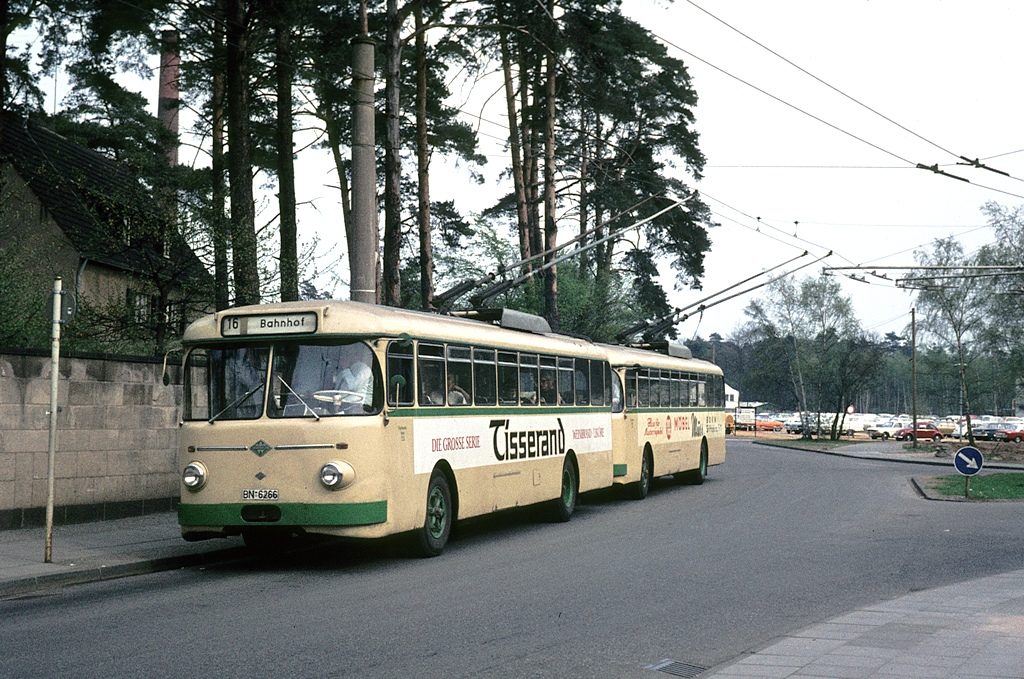
126 and 125 Venusberg terminus | @ Michael Russell 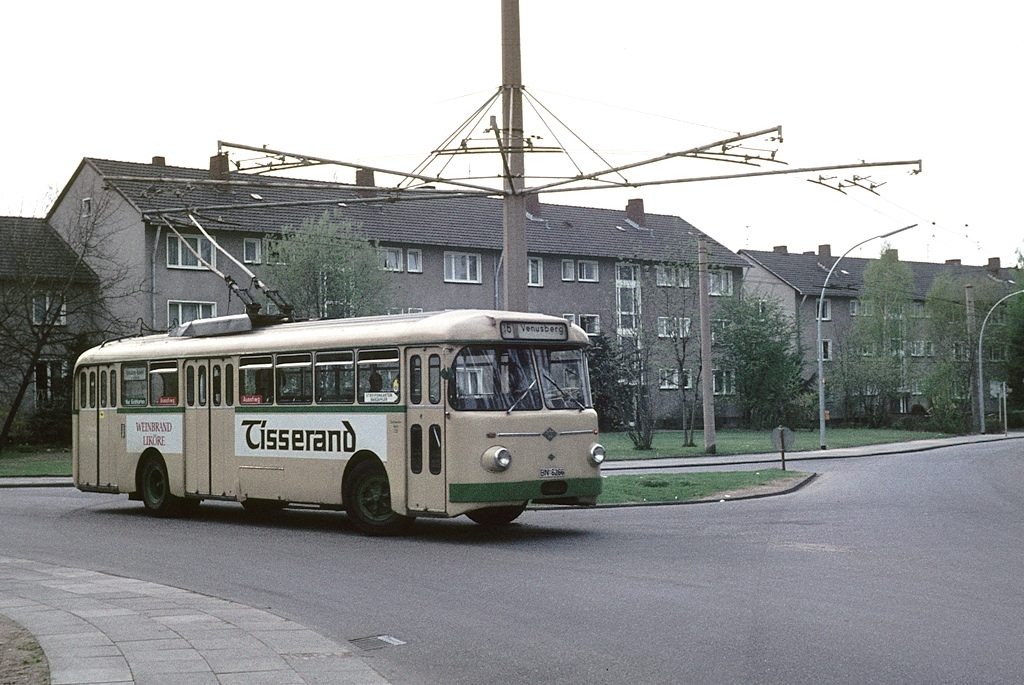
126 Venusberg terminus | @ Michael Russell 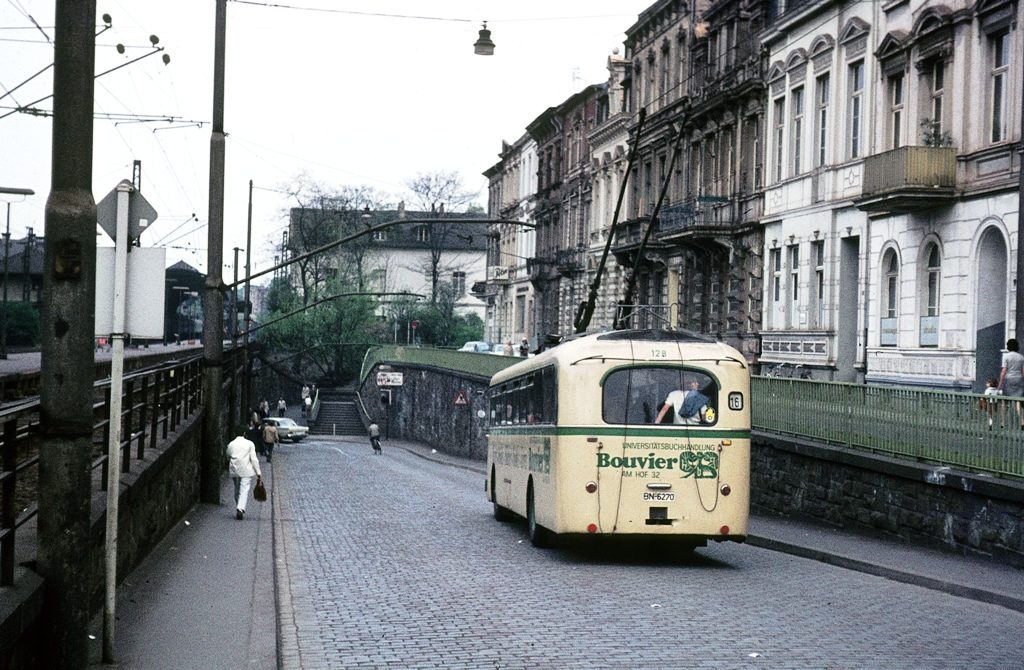
128 Herwathstrasse | @ Michael Russell 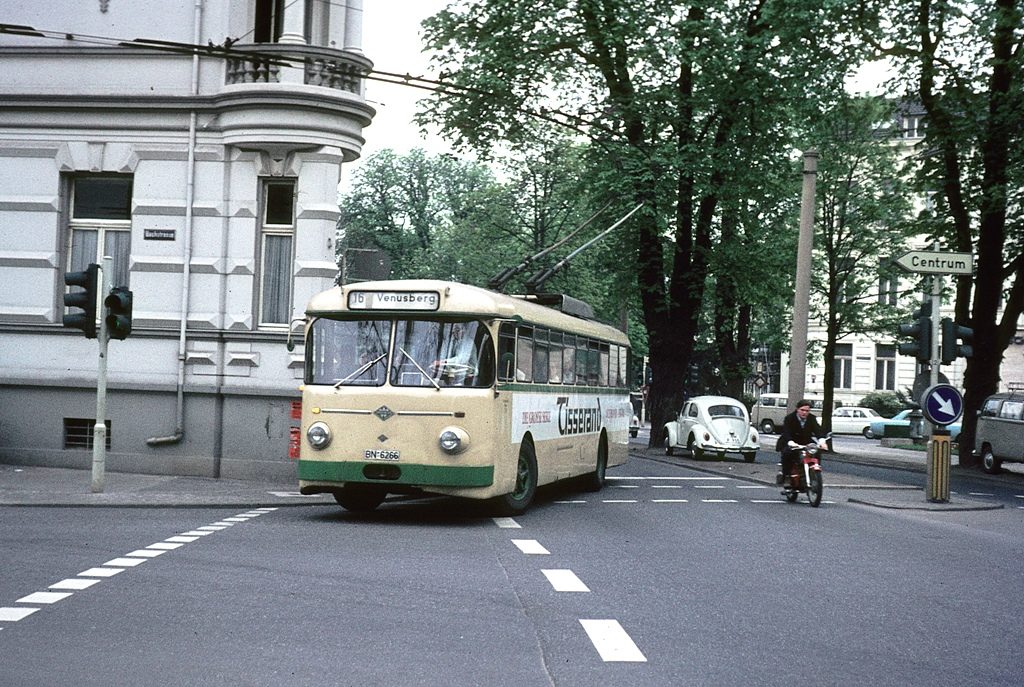
126 Beethovenplatz | @ Michael Russell 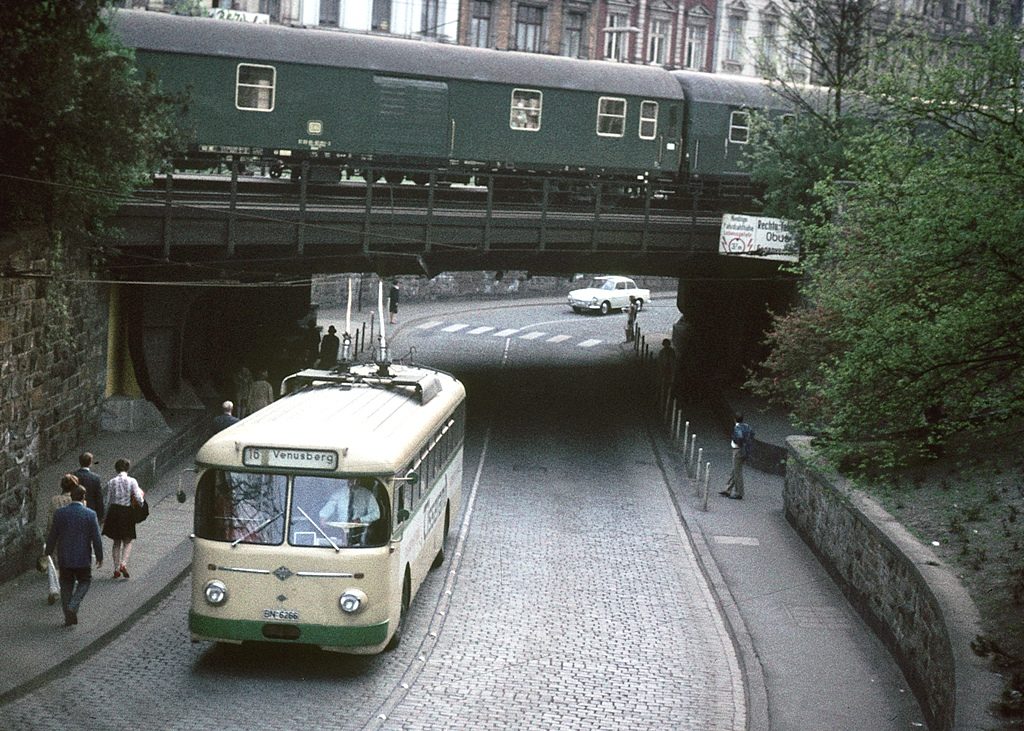
126 under railway bridge near Hauptbahnhof | @ Michael Russell
The closure in 1971
On June 30, 1971, in the evening around 7 p.m., Bonn’s trolleybus service came to an end – without much ceremony.
There were only two trolleybuses in service at all during the day, the other three being brand new Mercedes-Benz O 305 with automatic transmissions. The last two trolleybuses on line 16 were the Uerdingen 124 and 127 – and thus not only the two which were considered the best here in Bonn, but also those which moved to the Mürztaler Verkehrs-Gesellschaft in Kapfenberg, Austria, at the end of 1971 (there numbered 20 and 21, from 1978 no. 20 and 19).
When one of the drivers’s shift changed at noon on 30 June, trolleybus 124 was also replaced by a diesel bus, so no. 127 was the last trolleybus to run in Bonn. It started its final loop at around 6 p.m. at Venusberg, scheduled to take about 45 minutes. Afterwards, the vehicle was decorated just a little bit, and then it headed to its depot Karlstraße as Bonn’s very last trolleybus.
On 1 July 1971, the summer holidays began in North Rhine-Westphalia. When the schools started again after the holidays, no trolleybus were operating anymore in Bonn – SWB had started dismantling the remaining overhead line.
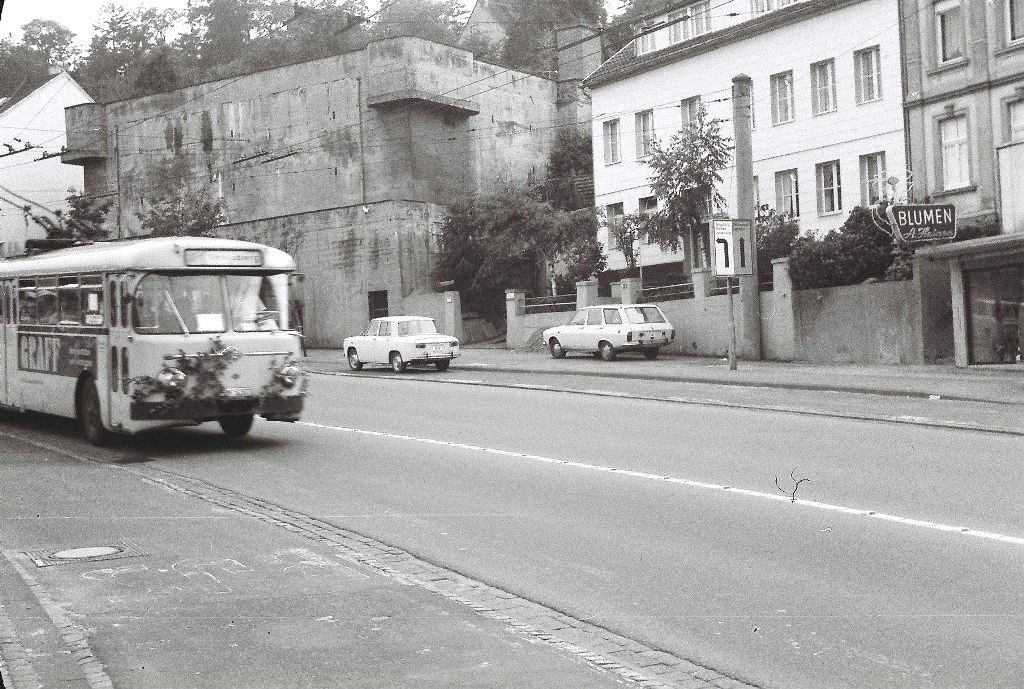
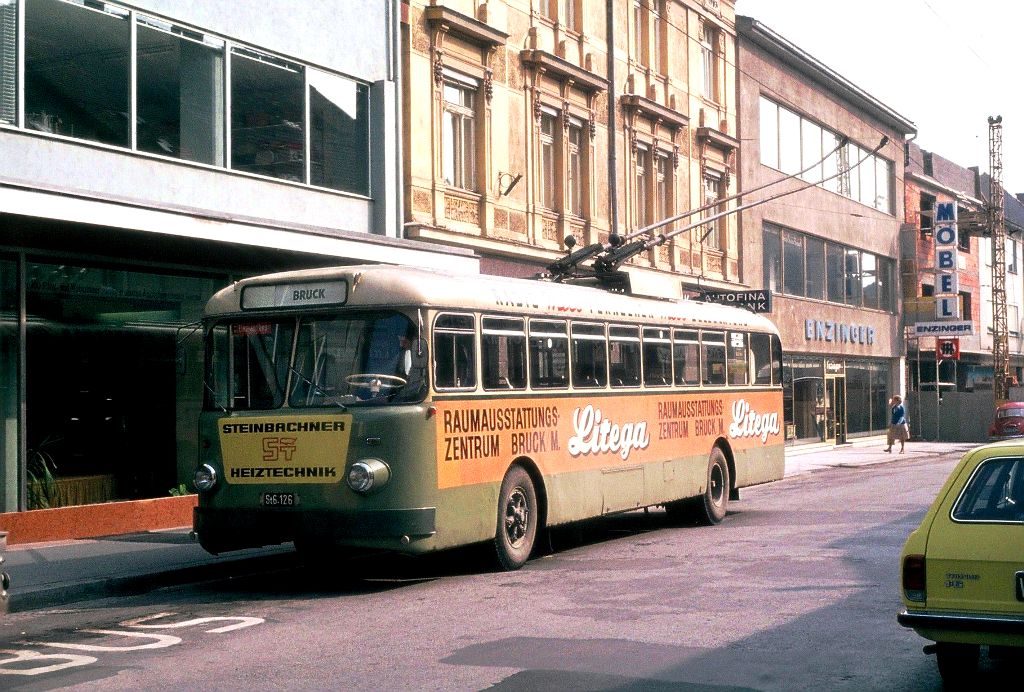
The routes
15 (since 1951-02-17): Gronau – Drachenfelsstraße (heute Kurt-Schumacher-Straße) – Bundeshaus – Siebengebirgsstraße (heute Heussallee) – Koblenzer Straße (heute Adenauerallee) – Stockentor (Gegenrichtung Koblenzer Tor) – Markt (Bischofsplatz) – Hauptbahnhof – Nordunterführung – Mozartstraße.
35 –Prolongation of line 15 (since spring 1952): Endenicher Straße – Ortskern Endenich – Euskirchener Straße – Ortskern Duisdorf – Lengsdorfer Straße (today Villemombler Straße) – Bundeswirtschaftsministerium – Lengsdorf
16 (since November 1953): Hauptbahnhof – Südunterführung (Gegenrichtung: Baumschulallee – Bachstraße – Nordunterführung) – Meckenheimer Allee – Clemens-August-Straße – Clemens-August-Platz Prolongation (June 1954): Im Wingert – Marienhospital – Friedrichsruh – Uni-Kliniken – Venusberg Kiefernweg
Fleet roster
201 – 204 1950 MAN MKE
205 1951 MAN MKE
206 – 208 1952 MAN/Kässbohrer MKE 2 1)
209 – 212 1953 MAN/Kässbohrer MKE 2 1965 = 109 – 112
213 – 214 1954 MAN/Rathgeber 690 HE C1 1965 = 113 – 114
215 1955 MAN/Kässbohrer MKE 2 s 2)
221 1953 Uerdingen ÜH III s 3)
222 1954 Uerdingen ÜH III s 4)
223 1957 Uerdingen ÜB IV s 5)
224 – 229 1960 Uerdingen ÜB IV s 6)
Notes:
1) 208 = 108 (1965 after more elaborate conversion to a single-man car)
2) 1965 = 115 (prototype for new technical developments)
3) 1965 = 121, with Henschel components, 1971 = Kaiserslautern spare part dispenser
4) 1965 = 122, with Henschel components, 1971 = Kaiserslautern spare parts dispenser
5) 1965 = 123, with Büssing components, 1967 scrapped after accident
6) 1965 = 124 – 129, with Büssing components, 124 and 127 = MVG Kapfenberg/A 20 and 21 (1971), MVG 21 1978 renumbered in 19; 125, 126, 128 and 129 = SVE Esslingen 31 – 34 (1971), all out of service in 1979
Sources:
- Hanke, H.: Der Obusbetrieb in Bonn, in: Omnibusspiegel No. 811 (1981)
- Pearson, D.: West Germany in Seventies – Bonn, in: Trolleybus Magazine No. 339 (2018)
- Sohns, P., Wöhl, U.: Obus-Atlas Deutschland, Verlag Dirk Endisch, Stendal 2017
- Stern, V.: Chapter „Bonn“ in: Kenning, L., Lehmann, J.: Obusse in Deutschland, Band 2 – Nordrhein-Westfalen – Hessen, Verlag Kenning, Nordhorn 2011
